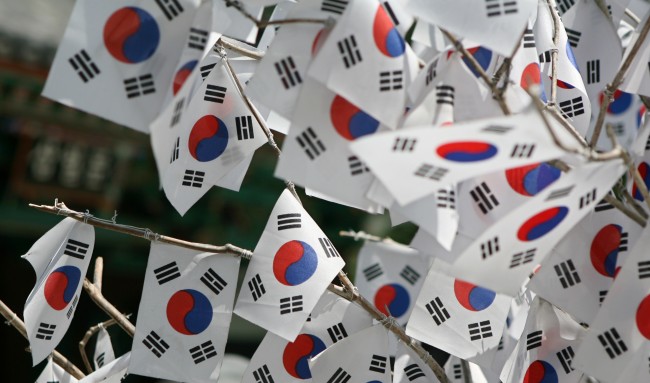by KARIN CHAN
editor@charactermedia.com
Today marks the 70th anniversary of Japan’s World War II surrender, which liberated the Korean Peninsula from Japanese colonial rule in 1945. In South Korea, the August 15 public holiday is known as Gwangbokjeol, which translates to “the day the light returned.” Meanwhile North Korea recognizes the holiday as Jogukhaebangui nal, or “Liberation of the Fatherland Day.”
When Japan annexed the Korean peninsula in 1910, Koreans were forced to adopt an assimilation policy, which prohibited them from speaking the Korean language, forced to adopt Japanese names and pledge loyalty to the Japanese emperor, according to the Encyclopedia of Modern Asia.
Dedicated leaders and student organizers planned public demonstrations and acted in opposition to the Japanese occupation during this long road to independence. Here are some major milestones, figures and events that led up to Korea’s Liberation Day.
Ahn Jung-geun
 Ahn Jung-geun, Korean independence activist and pan-Asianist. (Photo via KoreaBridge.net)
Ahn Jung-geun, Korean independence activist and pan-Asianist. (Photo via KoreaBridge.net)
On Oct. 26, 1909, Ahn Jung-geun assassinated Ito Hirobumi, Japan’s first prime minister and resident-general of Korea, at a train station in Harbin, China. Ahn, who was the lieutenant general of a Korean resistance army, had stashed a pistol in his lunchbox and shot Ito three times.
The assassination followed the signing of the 1905 Eulsa Treaty, which stripped Korea of its diplomatic sovereignty and made the country a protectorate of Japan. When asked by Russian and Japanese authorities what his motive was for killing Ito, Ahn listed 15 crimes Ito had committed, including forcing unfair treaties, pressuring Emperor Gojong to abdicate his throne and authorizing the assassination of Queen Min.
Ahn was executed by the Japanese government for his crime, but his pan-Asianist views were praised by Korea, China and even some Japanese. Last year, China built a memorial hall in honor of Ahn inside the train station where the assassination took place.
Korean Declaration of Independence
 (Image via Trazy.com)
(Image via Trazy.com)
On Feb. 8, 1919, a group of 600 Korean students huddled in a Tokyo YMCA auditorium for the first reading of the Korean Declaration of Independence. One month later, the declaration sparked a series of nonviolent protests across Korea known as the March 1 Movement in Pagoda Park. Hundreds of people gathered at the park on March 1, 1919 to listen to one student, Chung Jae-yong, read the proclamation aloud before the Japanese military used force to end the demonstration.
During the rally, Koreans repeatedly shouted the word “manse,” which roughly translates to “live 10,000 years.” For that reason, the March 1st Movement is also referred to as the Manse Demonstrations.
Yu Gwan-sun
 Yu Gwan-sun (Photo via KoreaBridge.net)
Yu Gwan-sun (Photo via KoreaBridge.net)
Yu Gwan-sun is one of the most celebrated Korean independence activists in history. After witnessing the beginning of the March 1st Movement, Yu, at age 16, organized a non-violent demonstration in Awunae Marketplace in Cheonan, where about 2,000 protestors gathered. During the protest, Japanese authorities killed Yu’s parents and arrested Yu along with other demonstrators.
Yu was later sentenced to seven years in Seodaemun Prison, where she continued to protest for independence for Korea and endured torture as punishment. At age 17, she died on September 28, 1920 after succumbing to her injuries. South Korea posthumously awarded her the Order of Independence Merit.
Gwangju Student Independence Movement
 Gwangju students protest against Japanese colonial rule. (Photo via mpva.tistory.com)
Gwangju students protest against Japanese colonial rule. (Photo via mpva.tistory.com)
The Gwangju Student Independence Movement can be traced back to October 1929 when a Japanese male student harassed a female Korean student at a train station. The incident sparked several anti-Japanese demonstrations and skirmishes between Japanese and Korean students in the streets of Gwangju.
On Nov. 3, 1929, Gwangju students refused to sing the Kimigayo, the national anthem of Japan, by either remaining silent or shouting for Korean independence. The students later went on a school strike and staged public demonstrations that demanded freedom of speech and assembly as well as the abolition of the colonial education system, according to Contentious Kwangju: The May 18th Uprising in Korea’s Past and Present. The movement soon spread nationwide, with nearly 200 schools and 50,000 students participating in the protests. In the end, several student leaders were imprisoned and more than 2,000 students were suspended from school for an indefinite period.
Korean Provisional Government
 Founders of the Korean provisional government (Photo via Chang-ho Memorial Foundation)
Founders of the Korean provisional government (Photo via Chang-ho Memorial Foundation)
Kim Gu, Syngman Rhee and An Ch’ang-ho among others formed the Korean provisional government after the suppression of the March 1st Movement. The government, based in Shanghai, unified the Korean resistance groups, according to Encyclopedia Brittanica. Kim Gu, also known for his efforts to see a unified Korea, landed on a nationwide poll that named him one of the three “founding fathers” of modern South Korea, the Diplomat.
___







